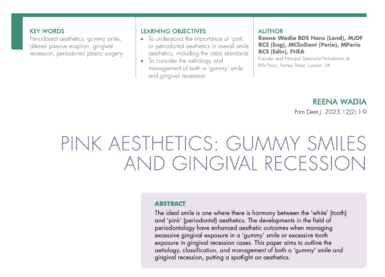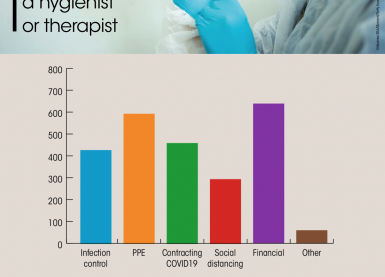Home/Articles
/ General Dental /
Reena’s Notes: How to Avoid Periodontal Litigation in General Dental Practice with Dr Ian Dunn
June 21, 2021

Statistics
- In the last few years, complaints have been increasing by 25-30% on a year on year basis in all sectors of dentistry.
- NHS negligence claims amounted to £550 million in 2008. In 7 years, this figure increased to £1.4 billion.
- The Dental Law Partnership analysed claims between 2013 and 2017 – there were 1888 successful claims and over £28 million was paid out to patients.
- When considering the top UK claims by value, figures from 2015 included: Perio 44.7%, Implants 28.8%, Implants and Perio 5.5%. So even the ‘riskier’ specialities such as maxillofacial surgery had less claims than Perio.
- The average award for a perio case is £25.6 K. The largest award so far has been £170K.
Minimising risk
- In the event of a claim: no notes = no defence, poor notes = poor defence, good notes = good defence. Documentation is just as important as clinical management.
- Perform a thorough and appropriate assessment with documentation, note down an accurate diagnosis or differential diagnosis (if not clear that warrants a specialist referral), provide appropriate treatment, review in a timely fashion, ensure appropriate documentation and reaction to findings at the review and discuss further treatment or referral as required.
- If the patient is unaware of the periodontal condition and asks you about whether they had this condition before, just say what you see today and explain you can’t comment on the past. Do not put your colleagues under a bus!
- Be nice, patients don’t sue dentists they like!
Assessment
- The BPE cannot be used for monitoring. A BPE should not be used around implants – instead use a 4 or 6PPC.
- For the 6PPC record both probing depths and bleeding on probing. Pockets are historical damage so it is important to record the inflammatory state as it tells us what is happening now.
- Ensure that your radiographs are adequate and appropriate. BPE code 3 and 4 need radiographs where the bone levels are visible. Bitewings do not always show crestal bone levels everywhere.
- Common radiograph issues that are picked up on when looking at cases include: not enough radiographs, no crestal bone visible, poor quality/not diagnostic and not reported on (% bone loss).
- Photographs can be a helpful form of documentation.
Diagnosis
- For perio litigation cases, 75% are to do with the failure to diagnose and failure to appropriately treat periodontal disease. Diagnosing is easy so always pick up that perio probe!
- Based on the clinical and radiographic findings, GDPs should be able to diagnose gingivitis, chronic and aggressive periodontitis and gingival anomalies (spot and offer referral for formal diagnosis e.g. lichen planus, desquamative gingivitis).
- Clinical observations are not the same as diagnoses. The diagnosis can be a game changer e.g. aggressive periodontitis would ideally be referred to a specialist.
- It is also important to communicate the diagnosis and problems to the patient.
- Ensure the patient knows that they are a perio patients – discuss, inform and provide written information. This is important even in a stabilised patient.
- If a new patient presents with treated stable periodontitis the notes should reflect that i.e. “patient has a history of periodontitis that is stable and based on shallow pockets and no BOP”. They will still require annual 6PPCs.
Smokers
- If the patient is a smoker, provide information on the negative effects of the habit on general and oral health. Inform the patient that they are more likely to lose teeth compared to a non-smoker (x3), more likely to have periodontal disease (x3-x7), more likely to have progressive disease (OR 3.8) and more likely to have reduced treatment outcomes (treatment less successful).
- Offer referral to an NHS smoking cessation clinic, as patients are more likely to quit with professional help. Smoking cessation advice should not be a one off event. Inform, ask and direct. It’s surprising how a very brief intervention can have such a big impact.
- Back up any verbal information with written information sheets/leaflets.
Referring for specialist care
- A recurring theme in litigation is failure to offer a timely referral to a specialist.
- BSP recommends referral for cases of complexity 3.
- Informed refusal – make sure the patient understands the consequences of what they are not accepting. E.g. if you don’t have further treatment, the disease may progress, you may lose teeth and you may need dentures. Letters can be useful especially for informed refusal.
Notes/documentation
- Your notes should include discussions such as explanations of the consequences of untreated disease. It’s helpful to use templates but these should be bespoke. Back up what you say with written information and document in your notes that you gave the patient written information.
- “OHI given” is not ideal – add more detail on what you did exactly e.g. modified Bass brushing technique shown in the mouth, use of yellow and green Tepes demonstrated.
- Perio largely a lifestyle disease and compliance is a huge part of successful outcome. If there is an obvious lack of compliance, it can be powerful to document their words e.g. “I just cannot get on with these little brushes”.
- Be objective not subjective e.g. about levels of plaque control.
- When describing treatment “NSPT URQ” is not enough detail. Add if it was supragingival/subgingival, were hand/ultrasonic instruments used, did you use LA?
- If a prescription is made to the hygienist, “Ref Hyg” is inadequate. It is a formal requirement to include an LA prescription if required and more detail of what you’d like the hygienist to do is recommended.
- When reassessing or reviewing the patient, describe the current periodontal status, not just ‘patient reviewed’.
- If abbreviations are used, they need to be widely recognised.
The summary was created from a webinar organised by the BSP. For more information on events organised by the BSP, please see:http://www.bsperio.org.uk/events/



